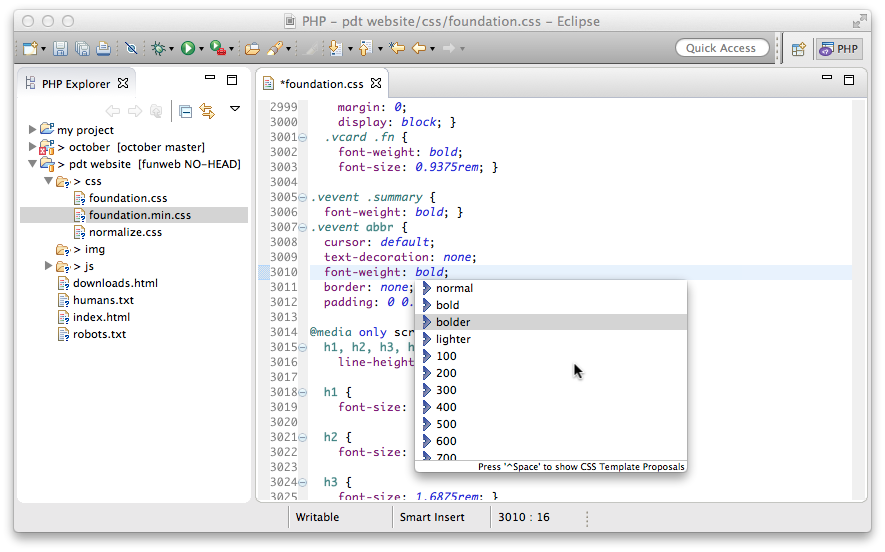

- How to use eclipse php install#
- How to use eclipse php pro#
- How to use eclipse php software#
- How to use eclipse php code#
- How to use eclipse php download#
It has been around since the early days of the World Wide Web when PHP originally stood for Personal Home Page, see PHP on Wikipedia for the history. PHP is a commonly used computer language used for developing websites and web based applications.
How to use eclipse php software#
You will be installing software on Windows, therefore you need to have Administrator rights to the Windows machine. Setting up a PHP development environment using the Eclipse PDT requires a lot of software downloading, therefore a good Internet connection is required. How to use eclipse php code#
Test writing and running PHP code on Windows. How to use eclipse php install#
Install PHP for Windows using Microsoft's Web Platform Installer.
How to use eclipse php download#
Download and install Java, which is needed to run the Eclipse IDE. Determine if your version of Windows is 32-bit or 64-bit. (PHP can be used to write scripts on normal PCs, though rarely, as PHP is popular for web based applications). The Eclipse PDT is used to develop PHP applications for deployment on web servers. (An IDE is an all in one program for writing, running and debugging code). Eclipse PDT is a version of the Eclipse Integrated Development Enivironment (IDE) for PHP use. What is Eclipse PDT? PDT stands for PHP Development Tools. This article covers installing the Eclipse PDT tools to allow for PHP development on Windows. In this case we change to Firefox.Developing PHP on Windows with Eclipse PDT If you want to test on other browser, click Window > Web Browser > select your_selected_web_browser. Well our PHP project has been run and the output shown in the IE browser shown below.ģ6. Select the Debug and Run tick boxes and don’t forget to rename this config file to testphp_config so that we can create another configuration for other web application testing later. Nothing has been changed here, select Open in Browser if it is not selected. Point to the file name (because we do not use index.* as the file name) as shown below (/testphp/testphpinfo.php). Our path mapping is shown in the following Figure. Select the project folder and click OK.ģ0. Put the C:\Apache Software Foundation\Apache2.2\htdocs\testphp in the path on Server: field. We need to map the path on server to the local path.Ģ8. Click the Browse button on the right of the File field.Ģ4. Select and right click the PHP Web Page node > New.Ģ3. If you encounter the following Windows firewall alert, unblock it.Ģ2. Show all information, defaults to INFO_ALLĢ0. Now, type (or copy and paste) the following phpinfo() function inside the PHP tag. There are many PHP templates that you can choose. Select and right click the project node > New > PHP file.ġ7. Just click Finish, nothing need to be set here.ġ6. Only two settings available: choosing the PHP version and treating ASP tags as PHP tags. Click the Configure Workspace Settings link.ġ4. The project contents default to the testphp that created under the Apache web document root folder. Fill in the project name for example in this case, testphp, tick the Enable project specific settings (only the different version of PHPs). Next, let try a very simple PHP project, that display the PHP information using the phpinfo() function. The PHP development environment launched as shown in the following snapshot.ġ2. Click Window > Open Perspective > PHP.ġ1. Then, we need to set the perspective for PHP. 
You may want to set this workspace as the default by ticking the tick box below the Workspace: field shown below.

Depending on your Apache web document root location, set in the nf file, change accordingly. Click Browse and find the Apache web document root.Ĩ. Otherwise we need to setup web server manually to test our PHP project.ħ. In this case we already set the Apache web document root so to make Apache run our PHP project or files, we need to put our PHP workspace under the Apache web document root. You will be greeted by the following nice flash screen.Ħ. You may want to create a short cut on your desktop.ĥ. Open the eclipse folder and double click/launch eclipse.exe. Under the pdt-all-in-one-S20071213_M1-win32 folder and there will be eclipse sub folder.Ĥ. We extract all the files to C drive and leaving the folder name to default.ģ. Download latest version of PDT from Eclipse website.Ģ.
How to use eclipse php pro#
Windows XP Pro SP2 + periodical patches + periodical updates…ġ.The machine specifications used in this task are: PHP engine (for parsing) already install and works.In this track we will try to run Eclipse PHP Development Tool (PDT) and then use this tool to test a simple PHP code. INSTALL AND USE ECLIPSE PHP DEVELOPMENT TOOL (PDT)







 0 kommentar(er)
0 kommentar(er)
